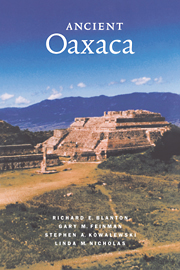Book contents
4 - The great transformation
Published online by Cambridge University Press: 05 June 2012
Summary
Now that we have looked in some detail at Monte Albán, we can investigate the broader consequences of its founding for people throughout the Valley of Oaxaca. The decision to establish a new capital seems to have set in motion a series of profound social changes in the region that probably were not entirely anticipated by those who had worked in favor of change or those who had followed or been forced to accept it. In the most general terms, the social system of the valley during Period I increased in scale, integration, complexity, and boundedness (Blanton et al. 1993:13–18). Scale refers to size, including more people and more human settlements. Integration indicates the number and kinds of social interactions and interdependencies between persons and groups. The evolution of the Monte Albán state, which fostered the dissolution of the old polity boundaries of the Rosario phase, resulted in an increased amount of social interaction over the entire region. Complexity refers to the number of unlike parts in a social formation or system and includes such features as specialized production and hierarchical differences between social segments (for example, status and power differences between individuals, groups, and communities). Boundedness refers to flows of materials, information, and people in and out of the region; boundedness increases with greater regulation and control of cross-boundary flows. Changes in scale, integration, complexity, and boundedness in the Valley of Oaxaca add up to a significant episode of sociocultural evolution. In this chapter, we look at what this sociocultural evolution meant in terms of changes in specific sites, social groups, types of specializations, technology, and other transitions.
- Type
- Chapter
- Information
- Ancient Oaxaca , pp. 68 - 110Publisher: Cambridge University PressPrint publication year: 1999

